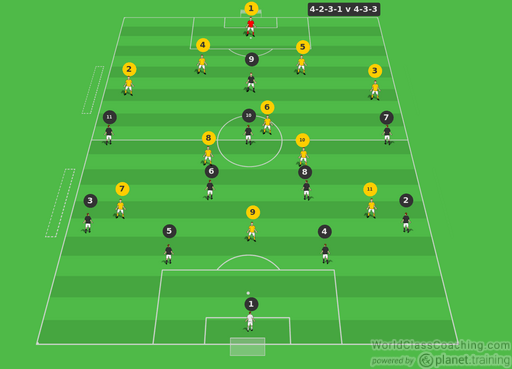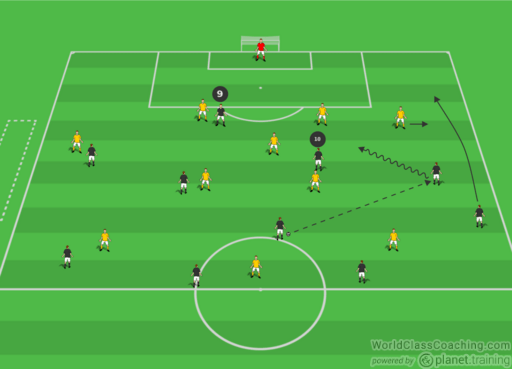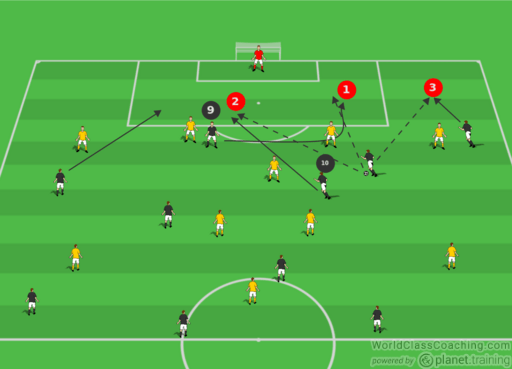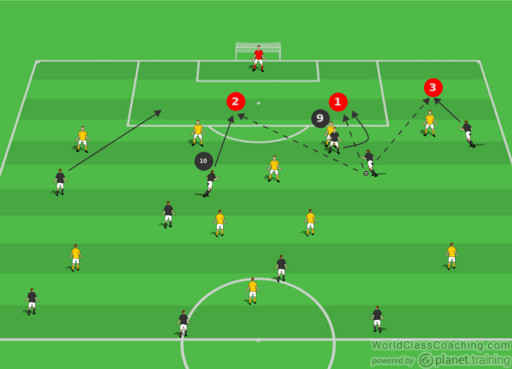By Sean Pearson
With the new USSF mandated birth year and small sided games changes there is a lot of trial and error regarding formations and systems of play. Instead of 8v8 formations, as coaches, we are now trying to figure out how to position our players in the new 7 v 7 and 9 v 9 formations. Some clubs have an academy structure where all teams must play the same formation, others allow coaches to choose what works for their team because players in each team have different attributes.
In these Systems of Play articles, I aim to address a wide range of 7 v 7, 9 v 9 and 11 v 11 formations and ways in which to use your players to your advantage.
Formation
The reason I have chosen the 4-2-3-1 to play against the 4-3-3 is there is pivotal space that the 4-3-3 allows when in the defensive third because of the placement of the central midfielders within the formation. You can also exploit the same space when playing against the 4-4-2 diamond formation. Because the central midfielders are higher and there is only 1 defensive midfielder there is a natural gap to drive into and cause the defense problems.

Movement and Penetration from the #9 & #10 in the Attacking Third
The key to unbalancing any defense is to move constantly into areas to make it difficult for the defenders to communicate with each other. If the striker is only moving side to side fairly slowly and in front of the defenders, it is easy for the CB’s to pass him on. It becomes a lot harder when more players aim to penetrate the defensive line and the striker runs behind defenders so they can’t see them. Then when you increase the speed of the penetrating runs, it becomes extremely difficult to understand where the players are going, to communicate this to your defensive teammates and to effectively execute it in the time frame.
As long as the attacking players stay either level with the ball or in front of the defensive line and static the defensive team has it easy, they want to slow your decisions down and make your play predictable.
In order to take advantage of the space, your wingers should be instructed to drive inside as often as possible when they receive the ball in the final third. As the ball travels towards the winger this is a sign for the full back to sprint to overlap them. This will help occupy the defending FB and pull them away from the CB’s (It can also be an option to penetrate the back line). As the winger drives inside, instruct them to drive towards the closest CB as this will be important in the movement of the striker and attacking midfielder. The striker should be between the two CB’s on the inside of the furthest one, the attacking midfielder should be opposite the CB the winger is driving towards.

As the winger gets closer to the CB the striker makes a run across the defensive line and curves their run behind that same CB. The CB is now caught in two minds, do I commit and step towards the ball or follow the striker. You want to take advantage of this indecision, either keep going and shoot or (1) slide the striker in with the outside of your foot to add disguise to it.
At the same time the #10 is making a diagonal run into the space the #9 has just left. If the CB the winger is attacking goes with the striker, (2) space opens up to slide the ball through to the #10. As a further option you can play the ball out wide for the overlapping FB to cross early.

Of course, players aren’t always in the right position and you don’t want to do the same runs all the time below the #9 &10 are in opposite positions but still create the same problem with runs.

Even if the #9 or #10 doesn’t get the ball, what your players are doing when attacking in the final third is making the defensive line uneasy and make it more difficult by adding numerous options for a forward’s pass. This makes it extremely uncomfortable for them because players are running behind them so now, instead of being compact and organized they become unhinged and either have to step to the ball or follow a runner for fear of them receiving a through ball which ultimately opens up space for someone else.
You #9, #10, wingers and FB’s need to understand they are making the runs for each other, not themselves. Sometimes they will get the ball, sometimes their teammates will get the ball, the more they make runs for each other, the better off the team is.
By Sean Pearson. Sean is also the author Coaching Team Shape in the 3-3-1, Coaching Team Shape in the 4-2-3-1 and Coaching Team Shape in the 4-3-3


